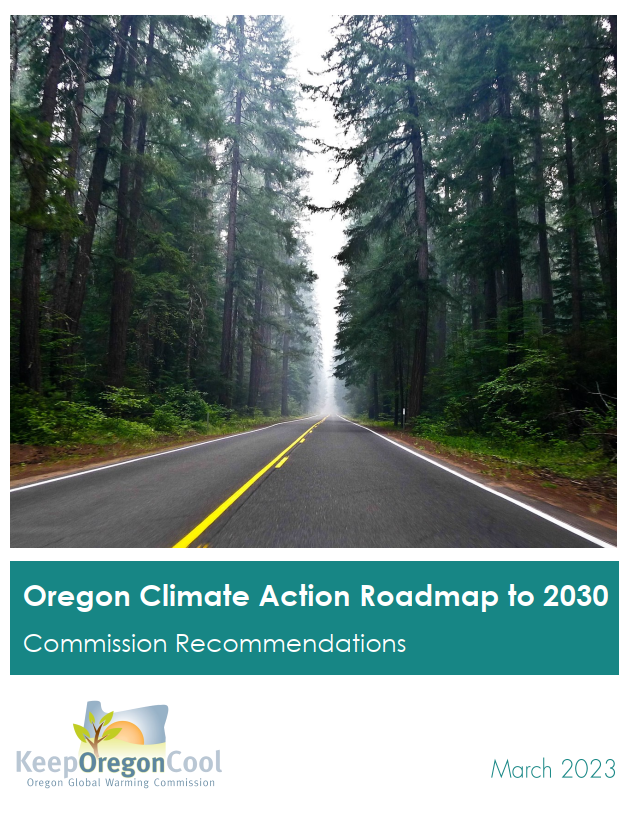Oregon Climate Action Roadmap to 2030
THE COMMISSION WORKEd TO ANALYZE AND IDENTIFY ACTIONS THAT CAN REDUCE GREENHOUSE GAS EMISSIONS WHILE CONTINUING TO GROW OREGON’S ECONOMY AND ENHANCE EQUITY AND QUALITY OF LIFE OF ALL OREGONIANS. THe Oregon Climate Action Roadmap to 2030 includes These Actions ALONG with extensive recommendations to inform state climate action moving forward.
OREGON CLIMATE ACTION ROADMAP TO 2030
The Roadmap to 2030 (published in 2023) consists of two documents – the commission’s Roadmap Recommendations and the Transformational Integrated Greenhouse Gas Emissions Reduction Project Report. The TIGHGER Project Report documents the technical analysis informing the Roadmap Recommendations.
The Roadmap Recommendations
The commission recommended six overarching strategies for maintaining and increasing Oregon’s climate action ambition:
Support robust and continuous implementation of existing climate programs and regulations.
Adopt updated state greenhouse gas goals consistent with the best available science.
Advance a set of additional climate actions – the TIGHGER Actions – that can help Oregon meet an accelerated greenhouse gas emission reduction goal of 45 percent below 1990 levels by 2030.
Support further study and analysis to continue to guide effective climate action over time.
Strengthen governance and accountability for Oregon climate action.
Position Oregon to take full advantage of federal investments in climate action.
Each of these recommendations includes several sub-recommendations – with a total of 26 sub-recommendations. A lot of work is ahead to ensure the Roadmap Recommendations are accomplished.
The TIGHGER analysis found that with continued implementation of existing programs and policies as planned, Oregon is on track to meet the Executive Order 20-04 2035 goal of at least 45 percent below 1990 levels by 2035.
In addition, the TIGHGER analysis considered what it would take to achieve the 2035 goal by 2030 consistent with the ambition required by the best available climate science.
The TIGHGER analysis found that Oregon can feasibly achieve the accelerated goal — while also creating thousands of new jobs and more than $120 billion in cumulative NET economic and health benefits in the state. A suite of 35 additional actions were identified to achieve the accelerated goal.
THE TIGHGER PROJECT REPORT
The commission funded development of the Roadmap with grant money from the U.S. Climate Alliance and worked with consulting firm Sustainable Solutions Group (SSG) to develop an Oregon-specific model that forecasts the potential emission reductions from existing and new mitigation actions Oregon could take. This work and analysis was called the Transformational Integrated Greenhouse Gas Emission Reduction (TIGHGER) Project.
The TIGHGER Project included seven key steps:
Create a Reference Case or Business-As-Usual forecast of GHG emissions.
Forecast the GHG emission reductions from Oregon programs and regulations already adopted.
Develop a list of potential emission reduction actions (actions).
Analyze the cost and GHG reduction amounts of each potential action and develop sector-based Marginal Abatement Cost Curves (MACC) showing the cost-effectiveness of each action.
Determine and analyze the co-benefits of each action.
Score and rank the actions using agreed upon evaluation criteria.
Create a new Roadmap to meet our GHG emission reduction goals with specific action implementation plans for each recommended action.
The TIGHGER Project Report further details the process and results. The results of the TIGHGER Project informed the Roadmap Recommendations.
Note: the Oregon Climate Action Roadmap to 2030 and TIGHGER Project Report were completed in 2023 under the name Oregon Global Warming Commission.
More Information
Sign up to receive Climate Change/Oregon Climate Action Commission updates by email.
Please contact Geoff Crook, Senior Climate Policy Analyst (geoff.crook@energy.oregon.gov)



